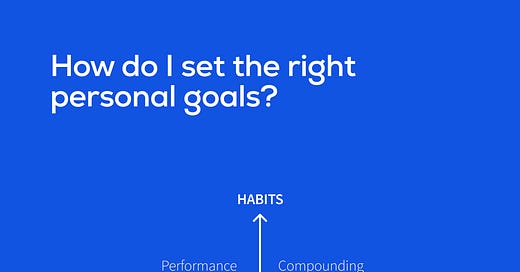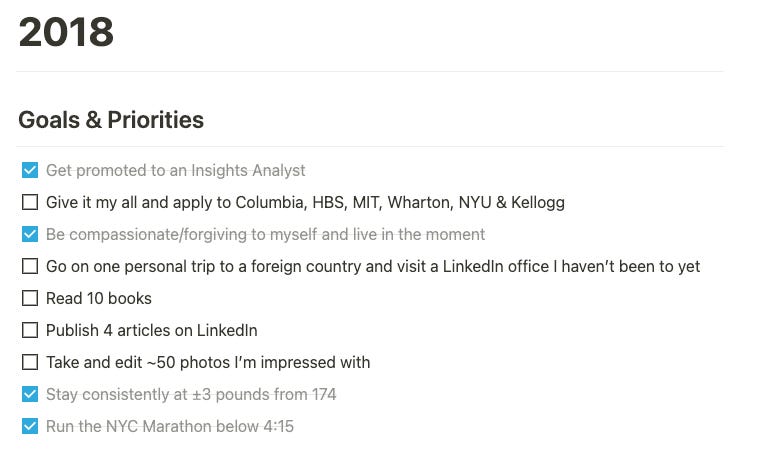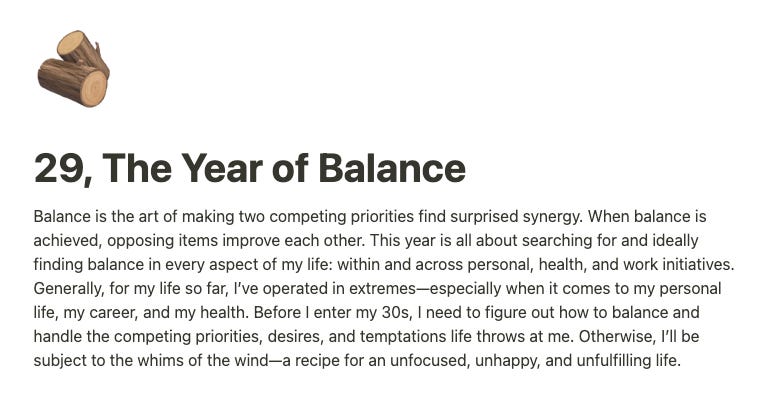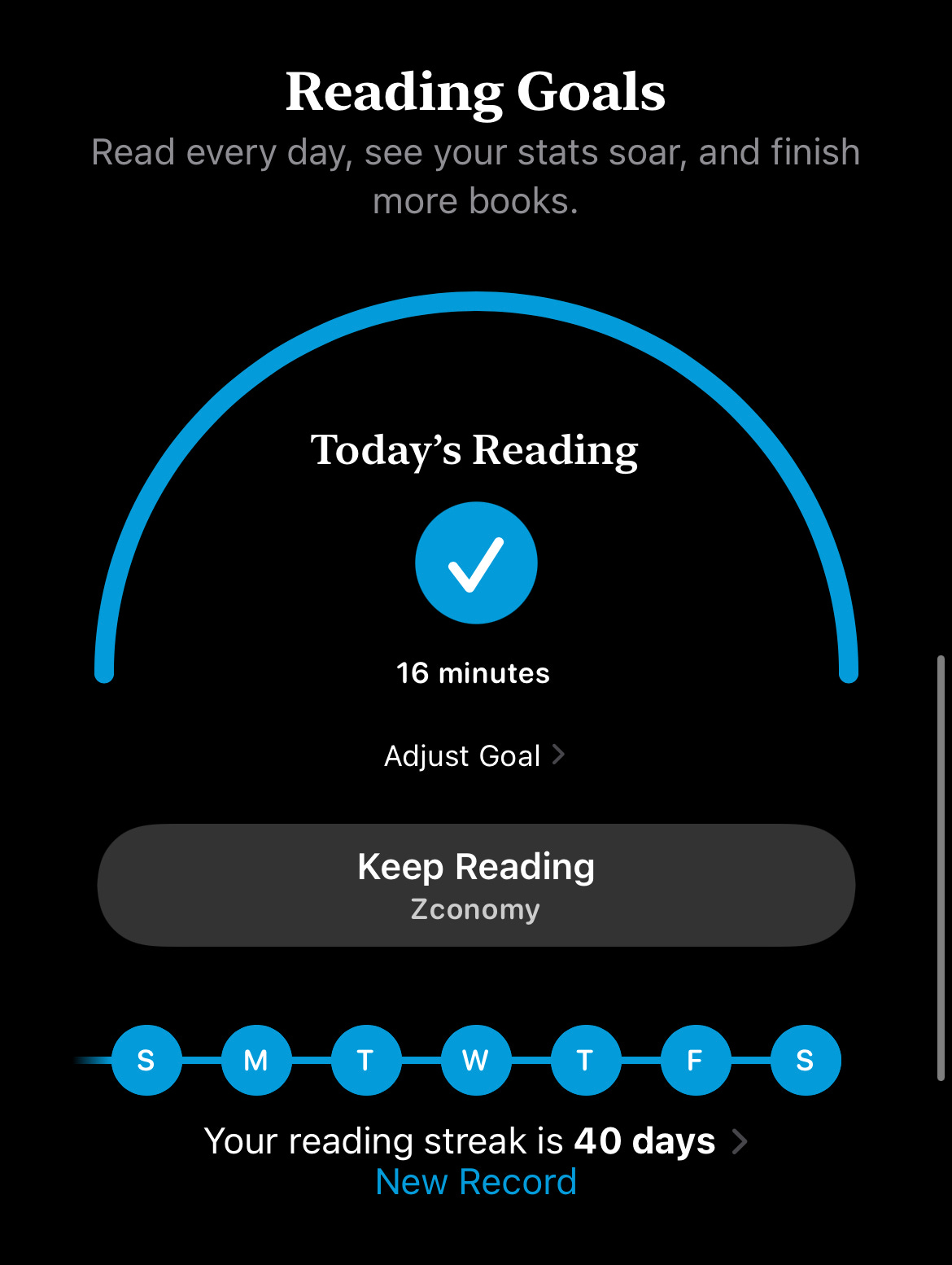How do I set the right personal goals?
Trade your lofty goals for identity-shifting and doable daily habits
👋 Hey again—I was traveling for the last few weekends so back at the keyboard on a Saturday morning. My birthday was last week, and it’s the time of year when I set a charter for myself. So, today’s post is all about setting the right personal goals for where you are in this moment of your life.
If you’re enjoying Gridology, it would mean the world to me to forward today’s post to someone else who may want to subscribe. Have them join 325 curious and growth-minded individuals also receiving 2x2 breakdowns of questions regarding life, business, careers, and (mental) health.
Let’s boogie:
I always thought I knew what I was doing when it came to setting SMART (specific, measurable, achievable, relevant, and time-bound) goals. Every December, when it came time to review my performance, my list of “achievements” often didn’t match my list of goals.
In fact, I barely accomplished any of the things I thought I wanted to do by the end of the year.
Here are some examples from 2017 and 2018:
This pattern of hitting 50% of my goals (at best) continued through 2020. The routine was clinical:
December: Think about things I’d love to have said I accomplished by this time next year. Create a laundry list of those items, and make them stretch, but achievable goals.
January: Set them in stone, and get started planning a few of the items on the list.
February to November: Status quo as usual. Continue living life the exact same way as I was before I wasted 10ish hours reflecting on my life and setting new goals I won’t achieve.
Maybe this sounds familiar because you may currently do something similar. We all have personal, health, and professional goals we’d like to achieve in the short and long term. Writing them down is a great way to manifest those things into reality.
That said, we can write down anything we want. We all know too well that merely writing down something doesn’t mean anything. I could write down that I want to be in the NBA. Great. So what? It doesn’t make a 5’8 guy with a 6-inch vertical any more likely to ride the bench next to LeBron. In fact, it may mean I have a distorted sense of athletic ability or that I’ve never actually watched the NBA. (Disclaimer: I stink at basketball and this example got out of hand).
While exaggerated, the point is clear: Writing things down is important for you to identify your goals. However, without a real plan—developed in achievable, small daily habits—success is slim to none.
In my last post, I discussed I was in the middle of reading Atomic Habits by James Clear. At the risk of sounding like another Millennial self-help bro who had his life changed by reading Atomic Habits, he does make honest and well-backed points about manifesting change in your life. Throughout the book I felt myself nodding along, wondering if I was Jim Carrey in The Truman Show. Example after example was something I had done: make unrealistic promises, aim big, start for a few days, stop cold turkey.
Had James Clear been watching my life on television and then using what he saw as examples for his book? I’m unconvinced.
At its core, Atomic Habits is about manifesting small actions through strategic planning. Want to lose weight? Make it really, really easy for yourself to go to the gym after you finish work by laying out your gym clothes and shoes so they are waiting for you when you get home. Want to read more? Charge your phone overnight in your living room, and put a book on your nightstand. Want to save money? Set up automatic bank transfers to move $20 a week to a savings account.
As creatures of habit, we gravitate towards the status quo. Only when a new easy alternative is introduced—one that aligns with the identity we want to craft and makes us feel better in our own skin—will we go out and grab it. Even then, habits are hard to maintain. They require nonstop strategic planning through environment design, automation, and practice.
That’s what today’s grid is all about. It’s time we all swap SMART goals for annual charters. While James Clear’s approach is all about setting up small daily habits that compound into massive, annualized gains, my approach is slightly different. It requires you to set your identity (or guiding theme) for the year. What principles will you live by? How do you act on those principles every single day?
On the x-axis, we have the underlying intent for your goal. Deep down, what’s the reason you want to achieve this item? Most goals, hopefully, are because you value them as part of your personal identity. However, some goals are on paper for performative reasons—perhaps a close family member or friend expects something of you which causes you to manifest that expectation into reality.
On the y-axis, we have how you set that goal. While this axis may feel like straight nuance—it is actually the most important aspect of actually achieving your goals. Are you setting them up as milestones—just like I did above? That’s a recipe for failure (we will discuss more).
Understanding the Grid
This grid will help you set and revise your goals to be achievable, rather than being a source of anxiety next year when you inevitably fall short (sorry for the bluntness, but this has always been a no-BS newsletter).
Compounding Growth
Your goals are true to your identity, and you set them as habits. Ink your charter. Identify where you want to make strides for the year and attack it. I started writing my goals in the form of an annual charter for my birthday last year. A friend and previous Gridology collaborator, Guillermo Echarte, introduced me to the idea. It starts with setting an intention for yourself. I spend about three to five weeks crafting this document—allowing it to sit and marinate in the background while I continue to process what should be included, discluded and refined. This year, I chose to focus on Balance. Here’s what the top of my document looks like:
This is my “vibe-check” for the year. Below the paragraph I shared with you all above, are three sections for the key areas of my life: personal, health, and professional. Each section has a guiding mantra, four to five principles, and a few tangible goals. The tangible goals are a mix of items. Some are habits I want to create by year-end. Some are milestone moments that act as a north star. The habits I’m choosing to build should compound and allow me to realize my goals. Whenever I start to feel unbalanced or disorganized, I reread this document. It resets my intentions.
If you’re interested in learning more about this process, I’m happy to chat or provide a template. At its core, this type of annual charter allows you to better define and then attain the goals you set for yourself.
North Star
Your goals are true to your identity, and you set them as major milestone achievements. This quadrant is where the goals I shared from 2017 and 2018 mostly land. They are big goals without a plan. They’re like shooting a bow and arrow with a blindfold on. Unless you’re Hawkeye, you’re going to miss. That said, they directionally serve a powerful point. Together, these goals define your aspirational identity—who you want to become. Once you have your North Star goals, you can easily break them down into more tactical, achievable habits that compound over time.
For example, take two North Star goals that appeared on both of my lists from 2017 and 2018: reading 10 or more books. This is a North Star goal. At the time, I believed I wanted to just read more. Because I didn’t carve out the right space and habit, that reading mostly consisted of low-brow news articles and Twitter threads. However, this year, I introduced a habit-based approach. I’ve already read one book this year, and I’m halfway through another. My North Star goal helped me define the identity I wanted to set for myself: to become a book reader. Thus, my daily habit is now to read a book for 10 minutes either right when I wake up or right when I get into bed before I fall asleep. This habit has a pretty slick reward—it “unlocks” my ability to go on social media. I read in the Apple Books app so there is a convenient reading tracker at the bottom. Here are my results since I started this new habit right before New Year’s Eve:
I’ve never read this consistently before in my entire life. Forty days of reading 10+ minutes in a row already enabled me to read more books in 2022 than I did in all of 2021. What started as a struggle at first has turned into a must-have daily routine. I even seek out to accomplish my 10 minutes of reading outside of the time windows in which it’s scheduled.
Performance Art
Your goals are performative, and you set them as habits. These are autopilot goals that typically begin by accident or for the wrong reason. Simply put, these goals are at odds with your target identity. They cause you to focus on the wrong things. That’s because most of the time these goals are never written down as intentional goals. They operate in the shadows. Performance Art goals are best explained with an example.
While I’ve never written it down on my list of goals for the year, it’s always been important for me to be informed about what’s going on in the country and world. That led to the number of newsletters I read a week to peak in 2020 (without counting, it was at least 20 or 25). However, when I took a closer look at my desire to be informed, I realized it came from a place of thinking I needed to be always connected and informed. So, in 2021, I unsubscribed from a few superfluous newsletters and became less OCD about having to have my email inbox have close zero unread newsletters at the end of the day. Instead, I’ve adjusted my goal to be reading the news on my time. That means I get to reading newsletters whenever I get to them. If they are more than a few days old, then I just delete them (2017 me would have gasped if he read that last line). The best thing to do with Performance Art goals is to audit your behaviors and reflect on why you do the things you do without thinking about them.
Mount Everest
Your goals are performative, and you set them as major milestone achievements. These goals are moonshots—items that typically go unresolved on a bucket list unless they are properly evaluated and acted upon. I had to learn Python on my list of things to achieve for two to three years before I finally did it. While I wanted to learn Python, it wasn’t anywhere close to an item at the top of my list. It was, however, something I thought I should do to become a better analyst. I also thought learning Python could potentially lead to a faster promotion. It wasn’t until I actually needed to learn Python for it to happen (there was a project I was working on in 2019 that forced my hand). Mount Everest goals either move to the North Star quadrant and then to Compounding Growth to be actioned on or, with greater reflection and prioritization, Mount Everest goals fade away from your grid entirely. Mount Everest goals are items that feel awesome in theory but haven’t been properly embedded into your new identity.
Grid Shortcomings
This grid doesn’t include joy. While realizing your goals is great, the journey is often more important than the final destination. So while things may be important to achieve personally or professionally, if you don’t have fun while doing it then these goals come at too high of a cost.
This grid doesn’t include how to leverage your community. My goals are rarely set alone. This year, Guillermo and I caught up and shared our goals with each other—talking about how last year went and what we wanted to change for this year. While these goals are totally my own, it is great to have to explain them to someone else. Like most things in life, your understanding of any topic becomes greater when you have to explain it to someone else. It causes you to deeply understand why you wrote down the things you did. It forces you to be hyperaware of what you’re doing and why you’re doing it.
This grid helps me think through how I set goals. While I find goalsetting a powerful way to realize your big, hairy, and audacious dreams, I frequently change how I do it. I’d be lying to you in saying that I found the answer that will empower you to achieve your dreams, but I’m confident that my approach to doing so right now is the best it’s ever been.
I expect it only to get better every year.
Life’s only as confusing as you let it be,
Ross









Could you please provide a template of the charter. I think the idea is so intentional and practical to helping me achieve my goals